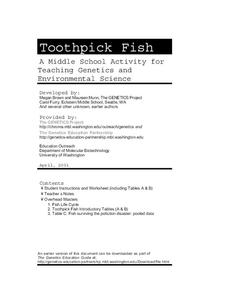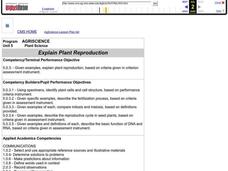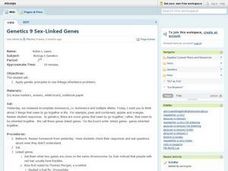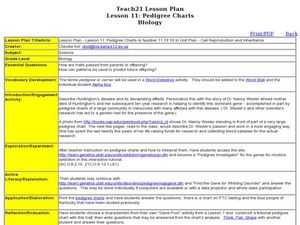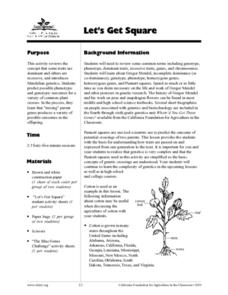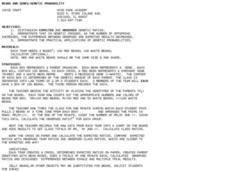Beyond Benign
Lucky Brand Genes: Genetic Traits
Explore single-gene traits in humans. After viewing a video introducing genetic vocabulary, individuals identify their phenotype and possible genotypes of specific traits. They consider both dominant and recessive traits. This is the...
Curated OER
Where'd You Get Those Genes?
Really a unit, this resource exposes middle schoolers to genetics at their level. They read interviews and biographies, trace a family tree, play games that simulate inheritance concepts, and more! Teacher's procedures, student...
Curated OER
Gene Puzzles
Students come to understand that in sexually reproducing organisms, such as humans, typically half of the genes come from each parent.
Students examine a fictional pedigree and determine which gene is responsible for a given trait. The...
University of Washington
Toothpick Fish
With colored toothpicks representing genes, youngsters practice passing them through generations of fish and learn about heredity. Consider this as an introductory activity since it does not represent recessive genes with lowercase...
Curated OER
Plant Reproduction
Students plant seeds in order to investigate and explore the questions: "How do seed companies develop varieties of plants?" and "What is the ideal plant?" Students will study related vocabulary and sketch seeds as they emerge. Students...
Curated OER
Rock, Paper, Scissors - Dominant and Recessive Traits from Parent to Offspring
Fifth graders understand the meaning of dominant and recessive. In this dominant and recessive traits lesson, 5th graders participate in a game and record results on a chart. Students relate experiment to genes. Students describe plants...
Curated OER
Principles of Heredity
Students model traits on genes using colored paper and tongue depressors to represent chromosomes. In this heredity lesson plan, students use their "chromosome sticks" to understand chromosome pairs, genes, dominant traits, recessive...
Curated OER
Evolution and Gene Frequencies: A Game of Survival and Reproductife Success
Young scholars research the population of Bengal tigers and their existence as either dominant or recessive. They explore the presence of fur on these tigers and its lethal combinations. Determinating the effect of random mating in a...
Curated OER
Parental Genes
Eighth graders explore how different organisms pass their traits to their offspring. In this life science lesson, 8th graders differentiate recessive and dominant alleles. They predict the phenotype based on the genotype of an organism.
Science Friday
Colorful Chromosomes
Everything is in the genes. Individuals observe 14 different traits of themselves. Using pipe cleaners and beads, the learners create models of a chromosome representing their traits. The class then compares and contrasts everyone's...
Curated OER
Wearing My Genes: Basic Principles of Heredity
Students explore heredity. In this science lesson plan, students examine what heredity is, distinguish the difference between the dominant and recessive genes, explain the difference between phenotype and genotype, and predict the...
Curated OER
Genes, not Jeans
Fifth graders examine the difference between dominant and recessive genes, and what happens when genes are combined. They complete a worksheet on genetics after observing if they can wiggle their ears or roll their tongues. They...
Curated OER
Incomplete dominance, Codominance, Multiple Alleles
Students explore the principles of incomplete dominance and codominance in genes. They apply genetic previously discussed genetic principles to determine solutions to inheritance problems including multiple alleles, incomplete dominance...
Curated OER
Sex-Linked Genes
Students review the concepts of incomplete dominance, co-dominance and multiple alleles. As a class, they are introduced to the concept of sex-linked genes and how they are passed to offspring. To end the instructional activity, they...
Curated OER
Complete Dominance Traits
In this lesson, 10th graders produces a different phenotype since the dominance is incomplete. Both parents have a spotted nose. After student have determined traits, they create drawings. Students chart thier respones in the graphich...
Agriculture in the Classroom
Roll of the Genes
Animal reproduction in sheep and cattle is explored with the help of Punnet squares. Scholars employ tools using probability to conclude the color of wool a sheep's offspring will have. Acting as animal geneticists, pupils then take...
Curated OER
Basic Genetics
Ninth graders discover where their physical appearance and personality traits come from. In this genetics activity, 9th graders learn about cells, chromosomes, DNA and genes. Students discover where genes come from as well as dominant...
Curated OER
Pedigree Charts
Students explain how offspring inherit traits from their parents. In this biology instructional activity, students investigate the genes for nicotine addiction using an interactive website. They construct a fictional pedigree using their...
Oklahoma State University
Hairy Heredity
Young scholars learn that heredity comes down to the flip of a coin with this cross-curricular math and science lesson. Using smiley faces as a model, students toss coins to determine which dominant or recessive traits will be passed on...
Towson University
Mystery of the Crooked Cell
Can your class solve the Mystery of the Crooked Cell? Junior geneticists collaborate to learn about sickle cell anemia in a fascinating lesson plan. The included materials help them to examine the genetic factors behind the disease...
Curated OER
Genes
Students explore the history, inheritance and mutations of genetics. For this genetic lesson students complete experiments on DNA sequences.
Curated OER
Mendelian and Non-Mendelian Heredity
Tenth graders discuss their physical features, and why they look the way they do. They listen as the teacher discusses DNA, alleles, and dominant or recessive genes. Students perform an experiment with different colored markers...
Curated OER
Let's Get Square
Learners predict possible phenotypic and genotypic outcomes for avariety of common plant hybrids. They review and explain the characteristics of dominant and recessive traits and explore Mendelian genetics. Students plot the possible...
Curated OER
Beans and Genes/Genetic Probability
Learners use 2 sets of colored beans to represent the genes of an organism. In this genetic probability lesson plan, students use the colored beans to represent the genotypes of offspring which they pull out of a box at random while the...
Other popular searches
- Recessive and Dominant Genes
- Dominant Genes Pictures
- Dominant Genes Hands
- Autosomal Dominant Genes
- Autism Dominant Genes
- Recessive, Dominant Genes
- What Are Dominant Genes
- Dominant Genes Tooth Gap
- Dominant Genes Tooth
- Co Dominant Genes
- Recessive Dominant Genes





